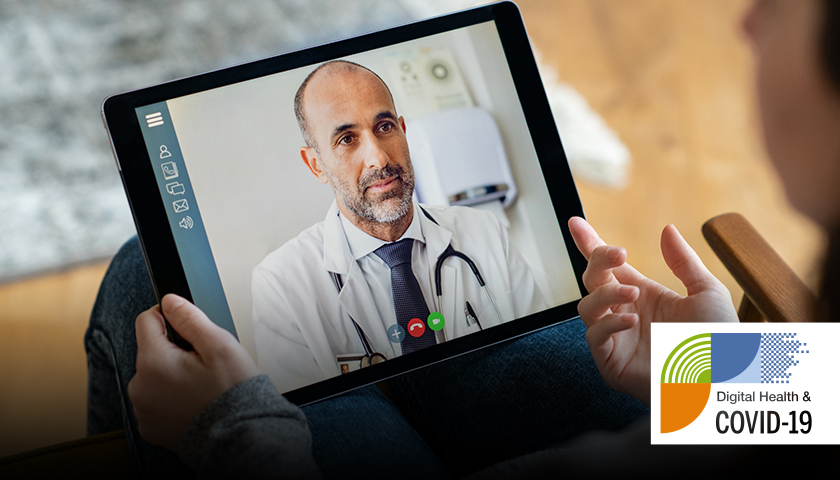NHS telemedicine ambitions approach a pivotal point

The UK government has said it is vital to adopt telemedicine across the NHS in response to COVID-19 – but is the health service ready to fully embrace this digital tech?
The rapid digitalisation of life during COVID-19’s acute phase has had a huge impact on healthcare delivery during the pandemic, part of which has included a major shift to telemedicine across the NHS.
Mirroring the acceleration of digital transformation in pharma, many face-to-face services have quickly been provided online or via telephone to keep patients away from overstretched and potentially infectious hospitals and GP surgeries.
The country is by no means out of the woods yet, and as I write this ‘only’ 77 people who tested positive for COVID-19 died yesterday in the UK (almost all in England). Nevertheless, plans for post-COVID healthcare are underway and digital health looms large within them.
The NHS’ digital future
As I noted in my last article, the signs of digital transformation – at a societal level, as well as across pharma – are everywhere. It’s a picture that also holds true for healthcare in the UK.
Speaking about the future of healthcare at the Royal College of Physicians recently, health and social care secretary Matt Hancock said COVID-19 had provided “a moment of exposure, of stark clarity”.
Matt Hancock, UK Health Secretary
"Coronavirus has tested every single part of our infrastructure, giving us a new appreciation for what works and what doesn’t.
"And we saw things change. I mean really change. I’ve lost count of the number of times someone said to me: 'what would have taken months took minutes'.”
COVID-19 has, he said, "catalysed deep structural shifts in healthcare that were already underway", and he cited as examples data-driven decision-making, working as a system and telemedicine.
Indeed, he noted how telemedicine had enabled care at the peak of the pandemic and that the NHS has been treating half of patients in outpatients and primary care online. The difference between healthcare delivery just a year ago is stark.
"In the four weeks leading up to 12 April this year, 71% of routine GP consultations were delivered remotely, with about 26% face-to-face. In the same period a year ago, this was reversed: 71% face-to-face and 25% remotely,” he said.
Earlier this year, on a single day in March, over 750,000 online assessments were carried out and this trend towards digital is, unsurprisingly given his penchant for technology, something the health and social care secretary wants to see continue.
"From now on, all consultations should be teleconsultations unless there’s a clinical reason not to. Of course, if there’s an emergency, the NHS will be ready and waiting to see you in person – just as it always has been.
"But if they are able to, patients should get in contact first – via the web or by calling in advance,” Hancock said.
Expanding healthcare services
Appropriate use of telemedicine also has the backing of the pharma and biotech sectors, and features in the Life Sciences Recovery Roadmap put together by industry and medical charity bodies such as the ABPI, EMIG and BIA. The publication provides an overview of the critical issues affecting the sector as it moves towards recovery and building new partnerships with the government and NHS.
“Progress on telemedicine must be maintained and enhanced, where appropriate, to reduce pressure on acute care, support patient self-management, improve choice and address health inequalities,” the Roadmap notes.
“However, further research is required to assess where telemedicine is suitable for vulnerable people, such as those with learning difficulties. It is also important that telemedicine is not allowed to create new demand or provide an alternative route for people with self-treatable conditions to access a GP consultation when they should be practicing self-care with support, if required, from a pharmacist.”
In terms of vulnerable groups, an article in The Lancet Digital Health last month concluded telemedicine had promise for prison populations, potentially improving health service access, reducing widening health inequalities and contributing to improved health outcomes.
Meanwhile, Marie Stopes saw the potential of telemedicine early on in the pandemic, launching a service for early medical abortion care in April. Its initiative, which is in-line with NICE’s abortion care guidance, includes a nurse-led telephone consultation for eligible women.
Andrew Goddard, Royal College of Physicians
The charity’s medical director Jonathan Lord said at the service’s launch: “We know first-hand the stress, anxiety and desperation that many women seeking abortion care are experiencing during the COVID-19 pandemic, and we are delighted that we have been able to implement an effective telemedicine service in response to the crisis.
“This would not have happened without a huge joint effort from both the independent women’s healthcare sector and the NHS, and we look forward to working in continued partnership to deliver the best possible care.”
But questions remain…
However, telemedicine must continue to improve if it is to deliver the best possible healthcare.
There are a range of safeguarding issues to be overcome, for example in sexual health, as the British Association for Sexual Health and HIV has noted. It held a joint webinar with The Faculty of Sexual and Reproductive Healthcare, which heard that telemedicine has been a great success during lockdown – improving access, providing a more patient-centred service and reducing complications and stress for women.
However, the webinar was also told how young people might not be able to plan how they engage with such services, or may be unable to make confidential telephone calls away from their family.
Another potentially problematic issue with telemedicine for healthcare providers is how it can be used to safely offer intimate examinations.
The NHS and Royal College of General Practitioners published the first version of their Principles of Safe Video Consulting in General Practice During COVID-19 at the end of May, but it wasn’t until July that a companion Key Principles for Intimate Clinical Assessments Undertaken Remotely in Response to COVID-19 was made available.
Such a delay is entirely understandable in the fast-moving, high-pressured environment of a pandemic, but it should also be a reminder of the balance to be struck between patient care and safety when applying digital health technology to sensitive areas of healthcare at high speed.
Still further issues emerge for telemedicine's use by rare disease patients and those with a genetic condition, a huge proportion of which need to avoid possible COVID-19 exposure while requiring frequent HCP consultations.
As the Genetic Alliance noted: "There are undoubtedly advantages to remote consultations, particularly where they supplement face-to-face consultations. But, we are learning from the COVID-19 pandemic experience that remote consultations for people living with genetic, rare and undiagnosed conditions cannot yet, and most probably never will, entirely replace the benefits of being physically in the same room as your healthcare professional."
There are potential technological issues too. In 2018, the UK’s Office for National Statistics (ONS) classified 10% of the population as “internet non-users”, meaning they’d either never gone online or hadn’t done so in the previous three months. And there’s a digital divide, or at the very least a digital gap, in healthcare too.
Responding to Hancock’s speech at the Royal College of Physicians, its president, professor Andrew Goddard, said the RCP has been arguing for using technology to transform the way in which services are provided for some time.
“But the government and the NHS must make sure that they bring everyone with them on this journey. In a recent survey, 50% of our members told us that they didn’t have access to a webcam."
Furthermore, early signs are that the massive spike in the use of remote NHS healthcare services during lockdown can’t continue. One rheumatologist in nearby Ireland ran 90% of his consultations remotely at the height of the pandemic, but by late July telemedicine accounted for just 10% of his workload.
Where next for telemedicine in the UK?
Interest in digital health technology has been following an upward curve for some time, but the demands of COVID-19 have generated a global wave of enthusiasm for its greater use. As a case in point, telehealth in the US is very much enjoying a moment in the sun right now.
Meanwhile, in the UK there’s clearly the political will and healthcare backing for wider use of telemedicine by the NHS, despite some, as-yet not entirely resolved, technological and safety issues.
So, as the country begins the slow process of trying to keep its infection rate curve ever-flatter, while holding on to those pandemic healthcare innovations that really worked, telemedicine in the UK finds itself at a pivotal point.
The question is: just how far will it return to the ‘old normal’ of underuse?
Based on the almost overnight explosion of its use during the pandemic’s acute phase, combined with telemedicine’s advantages for some patients of accessibility and responsiveness, a wider place for it in the post-COVID future of the NHS looks assured.
About the author
 Dominic Tyer is a journalist and editor specialising in the pharmaceutical and healthcare industries. He is currently pharmaphorum’s interim managing editor and is also creative and editorial director at the company’s specialist healthcare content consultancy pharmaphorum connect.
Dominic Tyer is a journalist and editor specialising in the pharmaceutical and healthcare industries. He is currently pharmaphorum’s interim managing editor and is also creative and editorial director at the company’s specialist healthcare content consultancy pharmaphorum connect.













